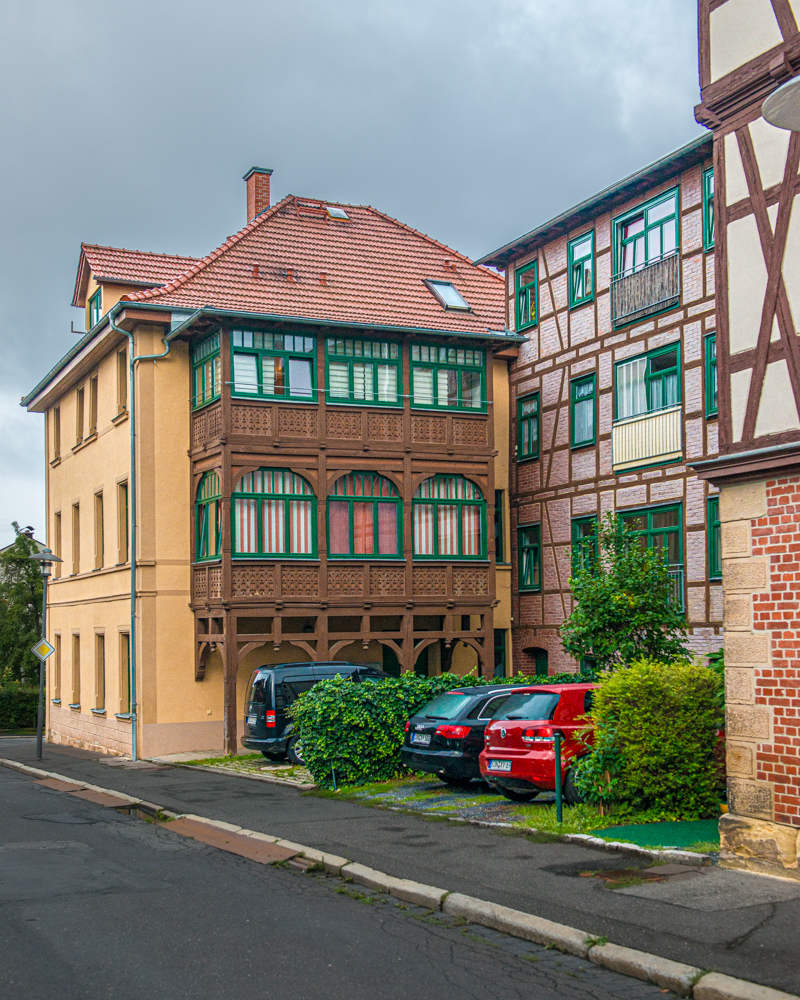
[… a small front garden] Framed towards the street by a living hedge, small trees and a purple flowering lilac bush, the garden consisted of two square lawns, known as “the Wiesle1” for short. They were framed with grey slate panels. Slate cladding can be found on many houses in Thuringia. It was usually attached to the north-facing facades to better protect the buildings from wind and weather.
But back to the meadow. It only served one purpose, namely bleaching laundry. To make this clear, I have to go into a little more detail about a typical Sonneberg wash day. The evening before, the laundry was thoroughly soaked in Imi. This agent was the equivalent of today’s “White Giant” and forced out the “gray haze”. The next morning, early in the morning, the laundry was put into a large washing kettle to be boiled. It was then brushed in large tubs with the help of curd soap on huge tumble boards, which can be seen again today on a river boat shuffle. When the laundry finally achieved the “brightest white” in the life of the housewives of that time, they were far from satisfied with that. The items were then taken to the meadow and carefully laid out in the sun to be bleached. As soon as they were dry, they were repeatedly sprinkled with water. When they finally had enough grass stains on them, they were dragged back to the washhouse, where they disappeared into the kettle again to be boiled.
One of our children’s favorite pastimes was playing tag around the meadow, which was of course strictly forbidden. It often happened that you took a shortcut while running and inevitably trampled on a piece of laundry, which aroused Aunt Anna’s terrible anger in particular and meant that you often didn’t see any blueberries from her for weeks as a punishment.
The laundry finally came out of the kettle as white as snow, and we could have happily hung it up to dry. But that was far from the case! It was then put back in the water and thoroughly “blued” with so-called laundry blue until, after this long procedure, it finally achieved the “brightest blue” in our grandmother’s life.
One can imagine that during such a strenuous day of washing there was little time to prepare lunch. So it usually consisted of just potato soup, but with a typical Thuringian delicacy. Before the war, butchers’ apprentices stood on many street corners with iron grills on which they prepared wonderfully fragrant sausages. One of these sausages then went onto the plate of the master of the house, the children only got half a sausage and a little more roasted breadcrumbs, and grandmother usually went away empty-handed.
The next day, the laundry was ironed on the kitchen towel. For this purpose, cast-iron black irons were heated on the stove. They came in different sizes, and the smallest was used to iron shirt collars and ruffles.
One day, when I was still a very small girl, I really wanted to do what my grandmother did. To get my crumpled doll’s dress back into shape, I secretly grabbed the smallest iron and in my overzealousness forgot to put a potholder over the red-hot handle to protect it. My screaming on her shoe bench startled my grandmother and before she could even get up, she called out to me to just drop the iron, whereupon I promptly took it in my other hand. She then expertly treated my blistered fingers with old home remedies, but she had not a word of pity for me, even though I was in terrible pain.
On that unfortunate evening, two pieces of candy were hanging on the kitchen window just once.
- I assume that this is a spelling mistake, and the word should be weise, which translates to meadow in English. ↩︎